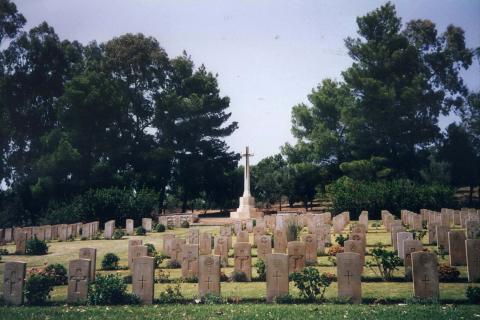Private Barry Charles Arliss came from Grimsby, Lincolnshire, and served in the Royal Artillery prior to volunteering for airborne forces in 1942.
He qualified as a military parachutist on course 36, which ran at RAF Ringway in November 1942.
Pte Arliss joined the 2nd Parachute Battalion as a reinforcement in North Africa, during Operation Torch, in January 1943.
In March 1943 the 2nd Para Bn was transported to the Tamera Valley having cleared a couple of prominent landmarks in the Beja sector. They were instructed to take over a hill feature with steep sides and covered in cork oak woods at Sidi Mohammed el Kassim from the Lincolns. Unsurprisingly this home became known to the men as ‘Cork Wood’. The subsequent engagement at Cork Wood also became known as the Battle of Tamera.
Conditions at Cork Wood were often extremely uncomfortable and hostile. The trees restricted visibility on some parts of the hill and also added to the hazards from shelling and strafing. The cover enabled the enemy in certain places to arrive undetected within 20 yards of the battalion frontline positions and to infiltrate in between the defences. During their occupation of the hill, rain filled their trenches and the wet weather meant clothing, boots and blankets were soaked and covered in sticky red mud. As a result the men were frequently wet and cold. The mud and slush often made movement up and down the slopes difficult. While occupying these defensive positions the battalion was subject to an onslaught of shelling, mortaring and strafing by enemy aircraft.
From 8 to 18 March the enemy launched a number of infantry assaults on the 1st Parachute Brigade's defensive positions, including three major attacks, in an attempt to dislodge the Paras. During this period the 2nd Para Bn suffered more than 150 casualties.
On 18 March the battalion withdrew to new positions known as 'The Pimples' overlooking Nefza railway station. These positions were in reality one hill with two pinnacles, the largest of these (known as Sidi Bou Delaa) was called 'Bowler Hat' by the British. The battalion handed over its positions to the 2/5 Battalion, The Leicestershire Regiment, on 19 March to take six days well earned rest at Tabarka.
During this period some of the British positions were overrun and the battalion went back into action on the evening of 27 March to retake ground previously held, including those at Cork Wood.
Private Arliss died in the battle on 28 March 1943, aged 20 years old, and is now buried at Tabarka Ras Rajel War Cemetery, Tunisia.
Cemetery photograph courtesy of CWGC.




Latest Comments
There are currently no comments for this content.
Add Comment
In order to add comments you must be registered with ParaData.
If you are currently a ParaData member please login.
If you are not currently a ParaData member but wish to get involved please register.